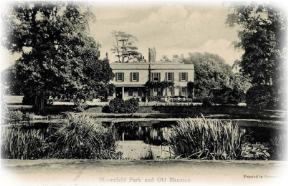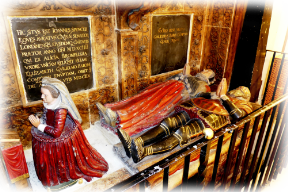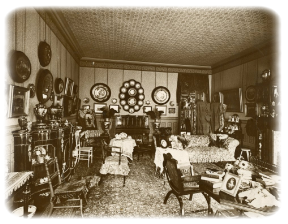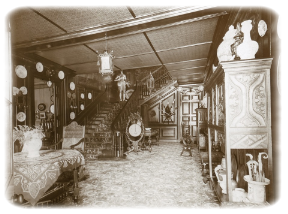History of Broomfield House - Broomfield House Restoration
Main menu:
the history of broomfield house and park
Broomfield House is a Grade II* listed building, and is the centrepiece of a public park which incorporates the remains of a formal Baroque landscape of ponds and avenues, focussed on the House, and is itself also Grade II listed. It lies adjacent to the Lakes Estate Conservation area. The House was classified as Grade II* in 1950. Included on the site are a Grade II listed stable block and covered gateway (of Tudor origin), as well as one of very few remaining Baroque water gardens in the UK. An early 18th century timber summerhouse overlooks the East Lawn. Both House and Stables are still enclosed by the original sixteenth -
The core of Broomfield House dates back to 1550. It was originally owned by John Broomfield, a leather merchant. In 1556 he sold ‘Bromehowse’ and its land to Geoffrey Walkenden. He was a Master of the Skinners’ Company and involved in the fur trade with Muscovy. Sir John Spencer then owned the estate from 1599. He was a Master of the Clothworkers’ Company, trading with the Ottoman Empire and the Levant. Lord Mayor in 1594-
After serving temporarily as a school (1907 to 1910), the House was then used in various ways, first as a maternity centre (1917) and then as a dental clinic from 1929. The House and Museum opened in 1925, providing a popular local attraction for most of the 20th century. Broomfield House is held in great affection to this day by those who visited it during that time. Sadly the house has remained derelict since it was reduced to a burnt shell following a series of fires in the 1980s and 90s.
Historically, Broomfield House is an interesting building. According to Paul Drury, the fabric of the house tells a story of the gradual evolution of a gentry house from medieval open hall to extensive Regency country house. The 16th century core is of considerable value in historical terms. The preservation of the decorative quadrant-
Until its demise the House contained many decorative items from the 16th to 20th centuries. Some of the most notable historical features of the house (currently in storage) are the central carved balustrade staircase (1726), the wood-
A report prepared in July 2009 by the Paul Drury Partnership (a Heritage Consultancy Firm) concluded: "Although badly damaged by fire and subsequent decay, elements of Broomfield House remain that are of ‘special architectural or historic interest’, and thus its inclusion in the statutory list remains justified. It is now principally of significance for the historical value of surviving fragments of 16th century fabric, its value as the setting and context for a major early 18th century interior (the stair hall), and as the focal point of a largely intact Baroque and earlier landscape... the building as a whole clearly remains listable." A study conducted by Donald W Insall and Associates in 1984 similarly concluded that the property could and should be preserved. Broomfield House also plays an important role in the formal landscape of the park – it is its raison d’etre.
The park retains most of its early 18th century framework, incorporating elements of 16th or 17th century boundary walls. Substantially complete Baroque landscapes are relatively rare, and are therefore significant. The double elm avenue, the formal ponds and the clairvoies were also positioned with reference to the house. The park is therefore missing its focal point – the two elements if restored would visibly complement each other as their original begetters intended.
The House’s heritage interest has been recognised in a number of studies in recent years. The following are the most significant:
an archaeological survey by Richard Lea and Andrew Westman of 1985
historical notes on the building prepared by Stephen Brindle of English Heritage in 1993
a report on the structural development of the house by Richard Lea of the English Heritage Buildings Recording Unit, February 1994
a survey and analysis prepared by the Parklands Consortium in 1997, which examined the park
The Significance of the House and Park, the Paul Drury Partnership, July 2009
It has a rich and interesting social history recorded in the Broomfield Estate papers in Enfield’s local history collection. It is a significant heritage resource which could be lost forever.
The Last Permanent Resident of Broomfield Park -
16 June 2020
The last permanent resident of Broomfield House was Sir Ralph Littler, an eminent barrister and significant figure in local government. He rented the house from the Lybbe Powys family from 1875 to 1901. Sir Ralph had a staff of 14 to run the house and gardens.
Although he left Broomfield House in 1901, his affection for it reflected in the article (below) remained. In 1902 as Chair of the Middlesex County Council he signed the agreement to pay a quarter of the £25,000 purchase price for the park and house, the remainder coming from Southgate Urban District Council. Among the conditions of the MCC contribution were that the House should be kept in good repair and the "Oak staircase and frescoes shall be preserved".
The architect commissioned in 2019 by Enfield Council to draw up plans for the reconstruction of the exterior of the House came across this article about Sir Ralph:
THE MIDDLESEX GAZETTE: SATURDAY FEBRUARY 28 1891
"Within twenty minutes, or even less, of leaving Kings Cross Station you reach a neighbourhood where the very names are redolent of the most perfect rusticity; Colney Hatch (always printed Coney in the days of our forefathers) may have long since lost its original signification as one of the side gateways or entrances to the Royal ' Chase of Enfield; but there is a true ring of the country in such pleasant sounding designations as Bush Hill and the Cherry Tree Inn.
First comes a district given up to dingy warehouses and squalid streets; next follows a suburban zone devoted to aged fishmongers, indigent poulterers, and Masonic orphans ; and the towers of Muswell Hill are scarcely out of sight before you find yourself on the modest-
Mr. Littler is by no means the first well-
As you walk briskly along the frost-
Your host has not yet exhausted the early history of Broomfield when you arrive at a lofty entrance gate surmounted by a crest of tangled ivy. Two minutes later Mr. Littler is welcoming you with characteristic cordiality to a house where a typical -
Sitting m one of the cushioned chairs of the low roofed room, with the firelight flickering comfortably on the polished panelling, you can just catch a glimpse through the old fashioned windows of the three lakes which in all probability once provided the inmates of the monastery with fish, Opposite the door runs the broad staircase decorated by Sir James Thornhill’s somewhat florid mythological pictures, in the foreground of which he has placed, with prophetic eye, the squirrel crest of the Littlers.
A man in armour guards' the square half-
The open fireplace is lined with bright blue Dutch tiles,stag’s antlers and blue china plaques crown the marble chimneypiece, and thick Turkish rugs are spread over the oak floor; There is certainly a strong temptation to indulge in the dolce far niente for which the hall affords so favourable an opportunity ; but Mr. Littler has treasures to show you both indoors and out.
In such a dining-
Mr. Littler is almost as fond of billiards as he is of books, and it is not surprising that his own particular sanctum should be shared between them. The figures at either end of his long carved desk are presumably typical of innocence, but the Chairman of the M.C.C.(not the great cricketing association, but the Middlesex County Council) is quite as much athome in the saddle as he is with the piles of statistics which cover the chairs and so it comes to pass that the inkstands which deal so efficiently with "rates"," assessments," and "subcommittees"are formed out of the hoofs of departed favourites, who thus serve the most indulgent of masters even in death.
The walls are wainscoted to the ceilings, and the trophies, of barbaric weapons and ivory tusks which stud them savour rather of the den of a mighty hunter than the study of a hard-
Itis in the long, drawing room that Mr. Littler’s adopted daughter (whose beautiful mare,Dainty,you admire presently) expends so much care over a collection of china which her Grace of Chandos at Minchenden might well have envied.
Your host is growing impatient for a"trot round" the property, or you would spend an entire day in examining the Viennese plaques,the black overmantel entirely devoted to Dresden or the Chippendale cabinets given up to blue Sevres, arranged and classified systematically according to its particular shade,
Mr. Littler has resolved on a brisk walk before afternoon tea and within a few minutes of turning your back regretfully on these matchless teacups their owner is showing you the monks’"stews"or fishponds, divided by broad gravel paths, the finest yews and firs in the whole district, and terrace, just a furlong in length, from which you obtain a charming view of the park with its double avenue of elms. Trudging up and down beneath the high garden wall, which bears so heavy a burden of fruit each succeeding September,
Mr. Littler talks to you of the days he spent at the London University with, such contemporaries as Lord Herschell, Sir Arthur Charles, the late Walter Coulson, and Tom Hood. After taking his ‘Bachelor’s degree, and reading diligently, like so many other of the old Northern Circuit men, with Mr. John Welch, he was duly called to the Bar at the Middle Temple. Ralph Littler soon fell into one of the most varied practices at the Bar, ranging from, ordinary cases at Nisi Prius and sensational criminal cases at Liverpool to Parliamentary petition, and from heavy compensation arbitrations to intricate criminal prosecutions.
Possibly his successful advocacy in defence of the captive Confederate Commissions (which won him the thanks of Mr. Jefferson Davis and his colleagues) was to some extent the means of first making his powers of argument, knowledge of law and tenacity of purpose known, but he has managed to do something more than maintain his pristine reputation. Before Parliamentary Committees he has scored almost as many notable "railway" victories as his friend and opponent, Mr"Sam" Pope, with whom he often fraternises during the adjournments at the Whitehall Club. It was only the other day that the standing counsel for half the great English railway companies was to he heard in his very best form at Carlisle where he marshalled his intricate facts, and examined his eighty witnesses in the Netherby murder trial with consummate skill.
Mr. Littler does everything which he undertakes with his whole heart, and is essentially an all round man. He has not only mastered every .detail connected-
has twice reigned over the " Northem Bar, of which he is one of the five founders,
If there is one incident in his career the recalling of which gives him particular pleasure, it is the rescue of the "British Beni Zoug Zougs "whom he happened to see at Constantinople, and whose case excited so much attention just ten years ago.
Mr. Littler is a great smoker, never retires to rest until he has finished his day’s work, and always sits down to breakfast at 8.30 a.m. These last-
you know, admiring courtiers may have once listened to the wit and wisdom of King James.
Be that as it may, it is probable that the royal jokes where not a quarter as amusing, and that the gentlemen of the suite had nothing so comfortable to sit on as the bearskin divans, the possession of which is so keenly contested by the faithful colley and Mr Littler’s superb dachshund Waldemar."
We also have photographs of part of the interior of BH in 1881 which show some features mentioned in the article. These photos, which are shown to the side, are held in the Enfield Local Studies centre, and were located for this article by Gary Boudier. The contents of the house, some of which are shown, but not needed in his new home in Kensington were auctioned off on site in 1901 (I wonder what happened to the suit of armour!).
NB the attribution of the frescoes to Sir James Thornhill was an historic mistake, not corrected until shortly before the 1984 fire. Any questions about other references in the article might be answered by Google searches, though other search engines are of course available….




